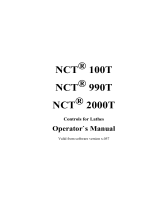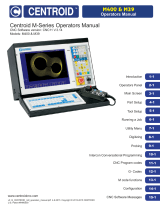
Section Page
Chapter 7 UTILITIES
7.1 Directory.............................................................................................................. 2
7.1.1 Program directory ................................................................................................ 2
7.1.2 Subroutine directory............................................................................................ 4
7.1.3 Directory of the seriel communications port (DNC)............................................ 4
7.1.4 Change PC directory via DNC ............................................................................ 5
7.2 Copy .................................................................................................................... 6
7.2.1 Copy a program into another............................................................................... 6
7.2.2 Send eeprom contents to a programmer............................................................... 7
7.3 Delete................................................................................................................... 8
7.4 Rename ................................................................................................................ 9
7.5 Protections ........................................................................................................... 10
7.5.1 User permission ................................................................................................... 11
7.5.2 Oem permission ................................................................................................... 11
7.5.3 Passwords............................................................................................................. 12
7.6 Compress ............................................................................................................. 14
7.7 Change date......................................................................................................... 14
7.8 Operation with EEPROM memory ...................................................................... 15
7.8.1 Move a program to EEPROM memory................................................................ 15
7.8.2 Move a program from EEPROM memory............................................................ 15
Chapter 8 DNC
8.1 Operating modes via serial lines.......................................................................... 3
Chapter 9 PLC
9.1 Edit ...................................................................................................................... 3
9.2 Compile ............................................................................................................... 10
9.3 Monitoring .......................................................................................................... 11
9.3.1 Monitoring with the PLC in operation and with the PLC stopped ..................... 18
9.4 Active messages................................................................................................... 20
9.5 Active pages (screens) ......................................................................................... 20
9.6 Save program ....................................................................................................... 20
9.7 Restore program................................................................................................... 21
9.8 Resources in use .................................................................................................. 21
9.9 Statistics .............................................................................................................. 22
9.10 Logic analyzer ..................................................................................................... 24
9.10.1 Description of the work screen ............................................................................ 24
9.10.2 Selection of variables and trigger conditions...................................................... 27
9.10.2.1 Variable selection................................................................................................ 27
9.10.2.2 Selection of trigger condition ............................................................................. 29
9.10.2.3 Selection of time base.......................................................................................... 31
9.10.3 Execute trace ....................................................................................................... 32
9.10.3.1 Data capture......................................................................................................... 33
9.10.3.2 Modes of operation ............................................................................................. 34
9.10.3.3 Trace representation ............................................................................................ 35
9.10.4 Analyze trace ....................................................................................................... 36






















